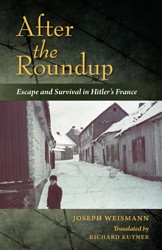The year 1947 may be remembered optimistically for the Nuremberg Trials, the Marshall Plan, and the United Nations vote to create the State of Israel. In journalist Elisabeth Åsbrink’s view, however, those landmark achievements obscure the dark developments that lay behind them.
Contrary to popular belief, the Nuremberg Trials were not originally intended to punish the perpetrators of the Holocaust. Åsbrink reports that the Allies mostly wanted to put Germany on trial for military expansionism. It was a young, Hungarian-born Jewish prosecutor, Benjamin Ferencz, who insisted on trying the leaders of the Einsatzgruppen, the roving death squads that murdered over a million Jews and other victims in the Soviet Union. Meanwhile, the right-wing French author Maurice Bardèche claimed that the evidence of genocide was a forgery, the first of many “revisionist” accounts of the Holocaust.
In the months before the birth of Israel, Great Britain’s main foreign policy concern in the Middle East was to maintain friendly relations with the Arabs. The Arab League opposed allowing any more Jews to enter the region, so Britain asked the members of the United Nations to prevent any refugees from traveling to Palestine. The British also turned back the 4,000 passengers aboard the Exodus, while a million Holocaust survivors languished in European refugee camps.
The climactic U.N. vote to create a Jewish state in Palestine resulted partly from backstage maneuvering, Åsbrink finds. The United States threatened to withdraw foreign aid from several countries unless they voted in favor; Haiti was promised a loan. The United Fruit Company pressured several Latin American countries. The plight of the Jews was not the main concern for most.
Elsewhere, Mussolini sympathizers were making common cause with right-wing movements in Britain, Spain, and Argentina, while a Swede named Per Engdahl dedicated himself to finding refuge for Nazi war criminals and organizing a new fascist movement. One of its members was Jean-Marie Le Pen. In their minds the war hadn’t really ended; it had only been driven underground.
1947 also provides glimpses of cultural figures and trends: Dior fashions, the music of Billie Holiday and Thelonious Monk, the literary romance between Simone de Beauvoir and Nelson Algren, the Holocaust poetry of Nelly Sachs and Paul Celan. But Åsbrink is drawn again and again to the fate of the Jews. And no wonder. Her grandfather in Hungary had been imprisoned by the viciously anti-Semitic Arrow Cross Party, and he died doing forced labor in Ukraine in 1943. Her father survived the Budapest ghetto, liberated when he was eight years old.
Åsbrink writes with a sympathetic voice in an accessible style, yet with an undertone of grief. She uses an anecdotal format reminiscent of the “newsreels” in John Dos Passos’s U.S.A. Trilogy, assembling her history as if putting together a puzzle piece by piece. It forms a picture which reminds us, as Faulkner put it, that “The past is never dead. It’s not even past.”
Bob Goldfarb is President Emeritus of Jewish Creativity International.





